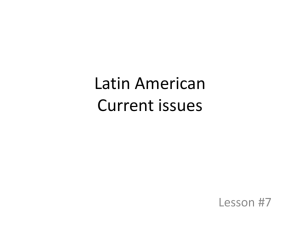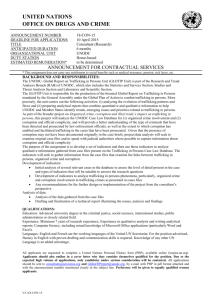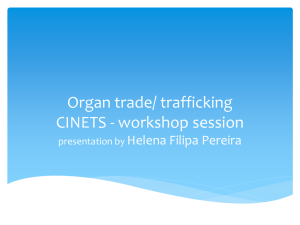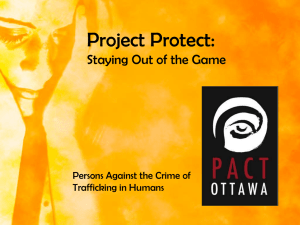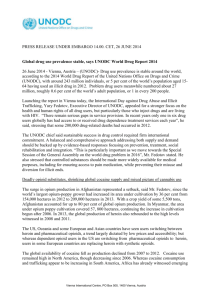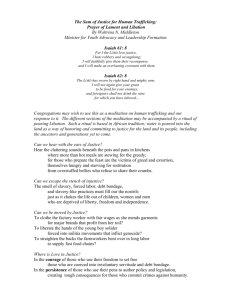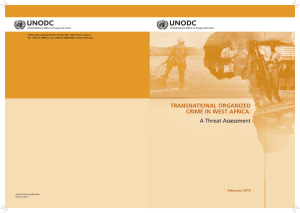Forum: - KLMUN
advertisement
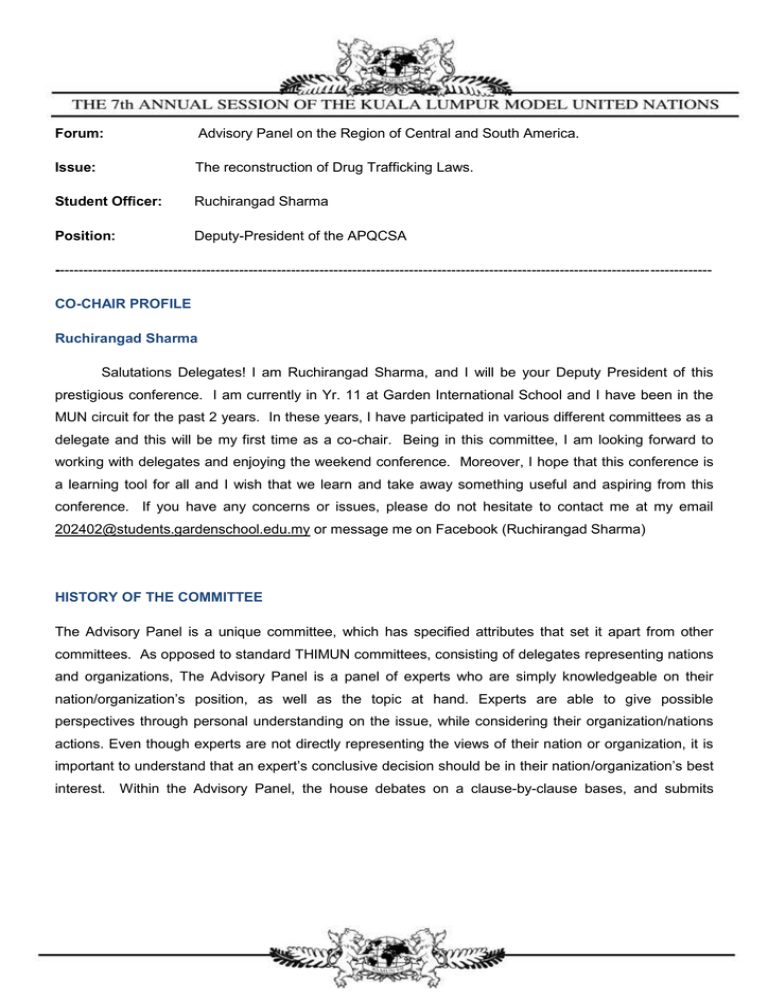
Forum: Advisory Panel on the Region of Central and South America. Issue: The reconstruction of Drug Trafficking Laws. Student Officer: Ruchirangad Sharma Position: Deputy-President of the APQCSA ------------------------------------------------------------------------------------------------------------------------------------------CO-CHAIR PROFILE Ruchirangad Sharma Salutations Delegates! I am Ruchirangad Sharma, and I will be your Deputy President of this prestigious conference. I am currently in Yr. 11 at Garden International School and I have been in the MUN circuit for the past 2 years. In these years, I have participated in various different committees as a delegate and this will be my first time as a co-chair. Being in this committee, I am looking forward to working with delegates and enjoying the weekend conference. Moreover, I hope that this conference is a learning tool for all and I wish that we learn and take away something useful and aspiring from this conference. If you have any concerns or issues, please do not hesitate to contact me at my email 202402@students.gardenschool.edu.my or message me on Facebook (Ruchirangad Sharma) HISTORY OF THE COMMITTEE The Advisory Panel is a unique committee, which has specified attributes that set it apart from other committees. As opposed to standard THIMUN committees, consisting of delegates representing nations and organizations, The Advisory Panel is a panel of experts who are simply knowledgeable on their nation/organization’s position, as well as the topic at hand. Experts are able to give possible perspectives through personal understanding on the issue, while considering their organization/nations actions. Even though experts are not directly representing the views of their nation or organization, it is important to understand that an expert’s conclusive decision should be in their nation/organization’s best interest. Within the Advisory Panel, the house debates on a clause-by-clause bases, and submits KLMUN Research Report | Page 1 of 6 clauses for proposals, as opposed to resolutions. After the passing of a proposal, the proposal is submitted to the Security Council (SC) for further debate. THE RECONSTRUCTION OF DRUG TRAFFICKING LAWS BACKGROUND INFORMATION. The trafficking of drugs especially in the Central and South American Area is a big issue within the whole country. At present day, there are almost 1.26 million Americans aged 12 and older, who are current illegal drug users. The drug cartels are known to play a lucre dative game which involves methods such as bribery, blackmail or death to get normal average Americans to work for them. This number is slowly increasing as south of the border, nearly 50,000 people have been killed in the last 5 years. The U.S. International Narcotics Control Strategy reports that 90% of cocaine reaches the United States through its southern border. Drug-related violence in Mexico has gotten so bad that it is now spilling over into states such as Arizona, which has suffered a rash of kidnappings and ransoms. (Arizona's 370-mile border with Mexico serves as the gateway for nearly half of all smuggled marijuana.) Texas' request for National Guard protection from Mexican drug crime prompted Director of National Intelligence Dennis Blair to declare last week that the Mexican government had lost control of its own territory. With the current drug trafficking laws already in play, the distribution or trafficking of drugs castigate the selling, movement and illegal import of unlawful substances, such as marijuana and other illegal drugs. The action takes against the offenders of the laws can vary depending on various factors such as the type and amount of drugs involved, the geographical area of distribution of the drug, and whether they targeted children. There are different sentences for the distribution of drugs and trafficking of these unwanted materials, the range going form 5 months to 3-5 years. In 2007 and 2008, cocaine was used by some 16 to 17 million people worldwide, similar to the number of global opiate users. North America accounted for more than 40 per cent of global cocaine consumption (the total was estimated at around 470 tons), while the 27 European Union and four European Free Trade Association countries accounted for more than a quarter of total consumption. KLMUN Research Report | Page 2 of 6 These two regions account for more than 80 per cent of the total value of the global cocaine market, which was estimated at $88 billion in 2008. The Current Situation At current levels right now, the whole world is consuming about 340 tons of heroin and with seizures giving an annual flow of around 430-450 tons of Heroin to the world Heroin Market. It is recorded that from that tally, opium from Myanmar and the Lao’s People’s Democratic Republic is approximately 50 tons while the remaining 380 tons is known to come from the Afghan Opium. An Approximate of 5 tons is kept in Afghanistan, and the remaining bulk is sent to other countries using routes going through and into the neighbouring countries of Afghan. Earlier this year on February 19th, Mexico’s biggest drug lord, Joaquín Guzman Loera was arrested after he had escaped from a high security prison in the US 13 years ago. Loera, also simply known as El Chapo due to his short stature was head of the Sinaloa Cartel, a criminal organization named after the Mexican Pacific coast state of Sinaloa where it was formed. El Chapo was responsible for over 2000 of the deaths and according to the U.S. Attorney General, the Sinaloa Cartel is responsible for importing into the United States and distributing nearly 200 tons of cocaine and large amounts of heroin between 1990 and 2008. For the North American Drug markets, the drugs usually come from Colombia and Mexico into Central America via sea using ships and boats called Narco-Submarines, which were hard to track using a radar system. Definition of Key Terms Trafficking- Dealing or trading of something illegal, in terms of drugs or humans in the form of slaves. Narco-Submarines: A type of custom-made ocean-going self-propelled submersible vessel built by drug traffickers to smuggle drugs. KLMUN Research Report | Page 3 of 6 Methamphetamine: Is a neurotoxin and potent central nervous system (CNS) stimulant of the phenethylamine and amphetamine classes that is used as a recreational drug and, rarely, to treat attention deficit hyperactivity disorder (ADHD) and obesity. Timeline of Events Date Description of event 1977 The Joint Committee of the New York Bar Association concludes that the Rockefeller drug laws, the toughest in the nation, have had no effect in reducing drug use but have clogged the courts and the criminal justice system to the point of gridlock. 1981 Congress commends the 1878 Posse Comitatus Act, which forbids the armed forces to enforce civil law, so that the military could provide surveillance planes and ships for interdiction purposes. 1984 U.S. catches 10,000 pounds of marijuana on farms in Mexico. The seizures, made on five farms in an isolated section of Chihuahua State, suggest a 70 percent increase in estimates that total U.S. consumption was 13,000 to 14,000 tons in 1982. 19th January 2001: El Chapo Escapes from a high security prison in Islas Marias, located in Mexico. 22nd February 2014: El Chapo is arrested in a beach side house while on holiday with his 4th wife, a beauty queen. Relevant International Actions/Past UN Efforts ANTONIO MARIA COSTA, Executive Director of the United Nations Office on Drugs and Crime (UNODC), recalled three occasions where Member States worked to strengthen the collective response to drugs, crime and terrorism. In 1998, a special session of the General Assembly launched a 10-year plan of action relating to the threat posed by illicit drugs. In 1999, Member States started the KLMUN Research Report | Page 4 of 6 negotiations for a Convention against organized crime, and signed the Palermo Convention in 2000. The same year, the Security Council created the 1267 Committee in response to international terrorism, after murderous attacks in Kenya and Tanzania, and moved quickly after 9/11 to strengthen that response through additional resolutions. https://www.unodc.org/pdf/report_1999-01-01_1.pdf Possible Solutions There are various different solutions that could be put forward to help and reduce this problem of drug trafficking, but the delegates should be looking at problems that apply to all the different countries in the committee and the solutions they come up with should be feasible and useful. An appropriate response would be to seek to strengthen the bonds between the state and marginalized communities dependent on or vulnerable to participation in illicit economies or usage of these illegal drugs. Efforts need to focus on ensuring that communities will obey laws – by increasing the likelihood that illegal behaviour and corruption will be punished via effective law enforcement, but also by creating a social, economic, and political environment in which the laws are consistent with the needs of the people. Another approach could be through education. People could be educated on the consequences of taking these drugs and teenagers especially aged 15-19 who are mainly those who are trapped in there illicit activities. Bibliography https://www.unodc.org/unodc/en/drug-trafficking/ UNODC. "Drug Trafficking." N.p., n.d. Web. < https%3A%2F%2Fwww.unodc.org%2Funodc%2Fen%2Fdrug-trafficking%2F >. http://www.un.org/en/ga/president/66/Issues/drugs/drugs-crime.shtml "United Nations, Main Body, Main Organs, General Assembly." UN News Center. UN, n.d. Web. <http://www.un.org/en/ga/president/66/Issues/drugs/drugs-crime.shtml>. KLMUN Research Report | Page 5 of 6 http://www.deamuseum.org/museum_ida.html "Illegal Drugs in America: A Modern History." Illegal Drugs in America: A Modern History. N.p., n.d. Web. <http://www.deamuseum.org/museum_ida.html>. http://www.dea.gov/druginfo/ftp3.shtml "DEA /Federal Trafficking Penalties." DEA /Federal Trafficking Penalties. N.p., n.d. Web. <http://www.dea.gov/druginfo/ftp3.shtml>. http://www.emcdda.europa.eu/html.cfm/index146646EN.html "Legal Topic Overviews: Penalties for Illegal Drug Trafficking." N.p., n.d. Web. <http%3A%2F%2Fwww.emcdda.europa.eu%2Fhtml.cfm%2Findex146646EN.html>. http://www.globalissues.org/article/755/illicit-drugs "Illicit Drugs." Global Issues. N.p., n.d. Web. <http://www.globalissues.org/article/755/illicitdrugs>. KLMUN Research Report | Page 6 of 6
